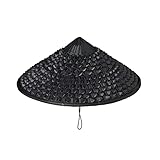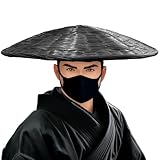The Best Japanese Straw Hat of 2023 – Reviewed and Top Rated
After hours researching and comparing all models on the market, we find out the Best Japanese Straw Hat of 2023. Check our ranking below.
2,125 Reviews Scanned
- Handcrafted Asian straw hats measure 16" wide and 6" deep.Surface painted black paint.
- Plastic lining head ring is stronger, not easy to break, wearing more comfortable.
- It can be use along Asian dress or it also can be used as a decoration.
- It has an adjustable drawcord that you can easily slide up or down to comfortably hold the hat in place.
- RICE HAT: Handmade of 100% bamboo straw, natural materials, lightweight and breathable. Samurai hat for men women size: 17" Wide and 7" High; Weight: 7.4oz (210g)/pc.
- ADJUSTABLE: Mens rice farmer hat features an adjustable, pull rope that you can easily slide up or down to hold your chinese bamboo coolie hat in place comfortably.
- COMFORTABLE: Plastic lining head ring is stronger, not easy to break, wearing more comfortable. Because a mesh keeps the rice field hat from touching your head, air can circulate, so there is a bit of airflow in there to help keep you cooler.
- OUTDOOR HAT: Bamboo straw keep the sun's heat away, and asian straw hats for men with large rim shielded your face and neck easily, great for use in summer or very sunny day. Also good for other outdoor activities such as gardening or walking your dog.
- PARTY HAT: Classic design conical hat with Asian style, perfect for all kinds of parties and festivals, like Halloween, music festivals, dress up parties and other occasions. This coolie hat also can be used as an asian-inspired decor for house, is a best gift for friends and family.
- Traditional farmer hat made from leaf and bamboo.
- Light weight straw hat designed for agricultural use.Great for gardening, fishing or outdoor activities.
- Natural fibers allow air to pass through and keep you cool.
- Protects you from sun and rain when you are doing yard work.
- You also can just use the Bamboo Coolie Hat as an Asian theme home decoration.
- Dia. 17 Inches/43cm, 8.2" /20.8cm Depth ,White streamer length 35 cm or 13.8 inches.
- Comes with head placement & adjustable tie rope.
- Perfect for, costume parties, talent shows, dance shows, dance competitions, prom costumes, homecoming, college parties, fashion shows, wedding receptions, high school proms, cosplay events,, Mardi Gras, Halloween.
- 1.Functional Sun Protection – Provides excellent shade and protection from the sun, making it ideal for outdoor work or gardening.
- 2.Handmade Craftsmanship – Each hat is meticulously handcrafted from durable bamboo, ensuring long-lasting quality and unique design.
- 3.Versatile Use – Perfect for cosplay, outdoor work, gardening, hiking, or cultural events, offering both style and practicality.
- 4.Lightweight and Breathable – Made from natural bamboo, the hat is lightweight and breathable, allowing for comfortable wear during extended periods.
- 5.Traditional Asian Design – The conical hat design reflects traditional Japanese aesthetics, making it a great accessory for cosplay or simply adding a cultural touch to your wardrobe.
Last update on 2025-07-05 / Affiliate links / Product Titles, Images, Descriptions from Amazon Product Advertising API
How Do You Buy The Best Japanese Straw Hat?
Do you get stressed out thinking about shopping for a great Japanese Straw Hat? Do doubts keep creeping into your mind? We understand, because we’ve already gone through the whole process of researching Japanese Straw Hat, which is why we have assembled a comprehensive list of the greatest Japanese Straw Hat available in the current market. We’ve also come up with a list of questions that you probably have yourself.
We’ve done the best we can with our thoughts and recommendations, but it’s still crucial that you do thorough research on your own for Japanese Straw Hat that you consider buying. Your questions might include the following:
- Is it worth buying an Japanese Straw Hat?
- What benefits are there with buying an Japanese Straw Hat?
- What factors deserve consideration when shopping for an effective Japanese Straw Hat?
- Why is it crucial to invest in any Japanese Straw Hat, much less the best one?
- Which Japanese Straw Hat are good in the current market?
- Where can you find information like this about Japanese Straw Hat?
We’re convinced that you likely have far more questions than just these regarding Japanese Straw Hat, and the only real way to satisfy your need for knowledge is to get information from as many reputable online sources as you possibly can.
Potential sources can include buying guides for Japanese Straw Hat, rating websites, word-of-mouth testimonials, online forums, and product reviews. Thorough and mindful research is crucial to making sure you get your hands on the best-possible Japanese Straw Hat. Make sure that you are only using trustworthy and credible websites and sources.
We provide an Japanese Straw Hat buying guide, and the information is totally objective and authentic. We employ both AI and big data in proofreading the collected information. How did we create this buying guide? We did it using a custom-created selection of algorithms that lets us manifest a top-10 list of the best available Japanese Straw Hat currently available on the market.
This technology we use to assemble our list depends on a variety of factors, including but not limited to the following:
- Brand Value: Every brand of Japanese Straw Hat has a value all its own. Most brands offer some sort of unique selling proposition that’s supposed to bring something different to the table than their competitors.
- Features: What bells and whistles matter for an Japanese Straw Hat?
- Specifications: How powerful they are can be measured.
- Product Value: This simply is how much bang for the buck you get from your Japanese Straw Hat.
- Customer Ratings: Number ratings grade Japanese Straw Hat objectively.
- Customer Reviews: Closely related to ratings, these paragraphs give you first-hand and detailed information from real-world users about their Japanese Straw Hat.
- Product Quality: You don’t always get what you pay for with an Japanese Straw Hat, sometimes less, and sometimes more.
- Product Reliability: How sturdy and durable an Japanese Straw Hat is should be an indication of how long it will work out for you.
We always remember that maintaining Japanese Straw Hat information to stay current is a top priority, which is why we are constantly updating our websites. Learn more about us using online sources.
If you think that anything we present here regarding Japanese Straw Hat is irrelevant, incorrect, misleading, or erroneous, then please let us know promptly! We’re here for you all the time. Contact us here. Or You can read more about us to see our vision.
FAQ:
Q: What is the traditional Japanese hat?
A: Traditional Japanese Hats for Men Kanmuri. This very formal hat dates back to the Heian era (from the late 700s to the end of the 12th century). Eboshi. This pointed black cloth cap was worn by men of all social strata. … Sugegasa. The sugegasa is the Japanese version of the conical straw sunhat worn throughout eastern Asia. … Hachimaki. …
Q: What is the name for Japanese straw coat?
A: A mino (蓑) is a traditional Japanese garment, a raincoat made out of straw. Traditional mino are an article of outerwear covering the entire body, although shorter ones resembling grass skirts were also historically used to cover the lower body alone. Similar straw capes were also used in China, Vietnam and Korea .
Q: What is the name of this Japanese hat?
A: A kasa ( 笠) is a term used for any one of several traditional Japanese hats. These include amigasa and jingasa . Kasa is the correct way to pronounce the word when it stands alone.
Q: What is a Japanese bamboo hat called?
A: In China, it is called dǒulì (斗笠), literally meaning a “one-dǒu bamboo hat”, (笠帽, 竹笠). It is known as sugegasa (菅笠) in Japan, do’un (ដួន) in Cambodia , koup (ກຸບ) in Laos, khamauk (ခမောက်) in Myanmar, terendak in Malaysia, caping in Indonesia, and salakot in the Philippines.





